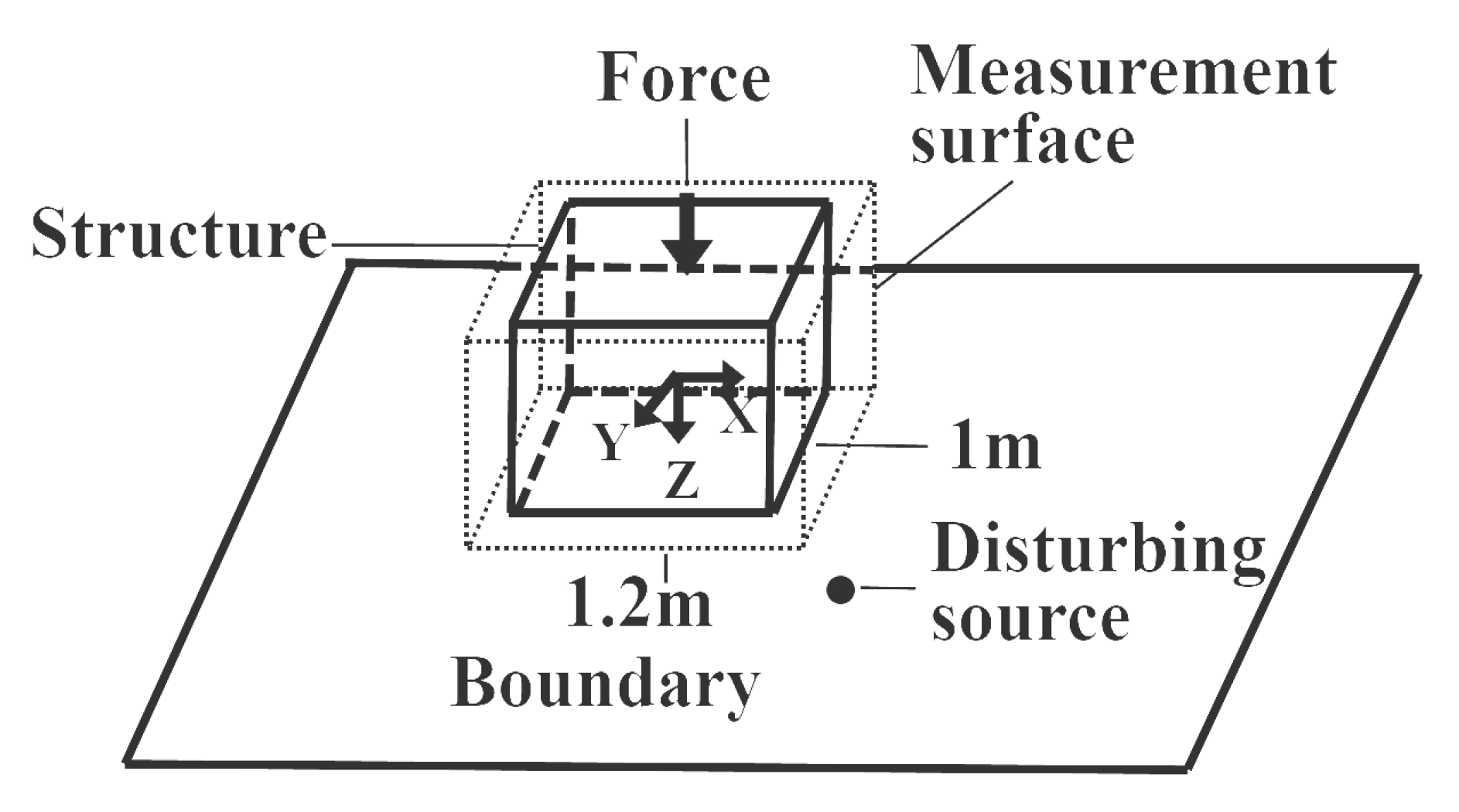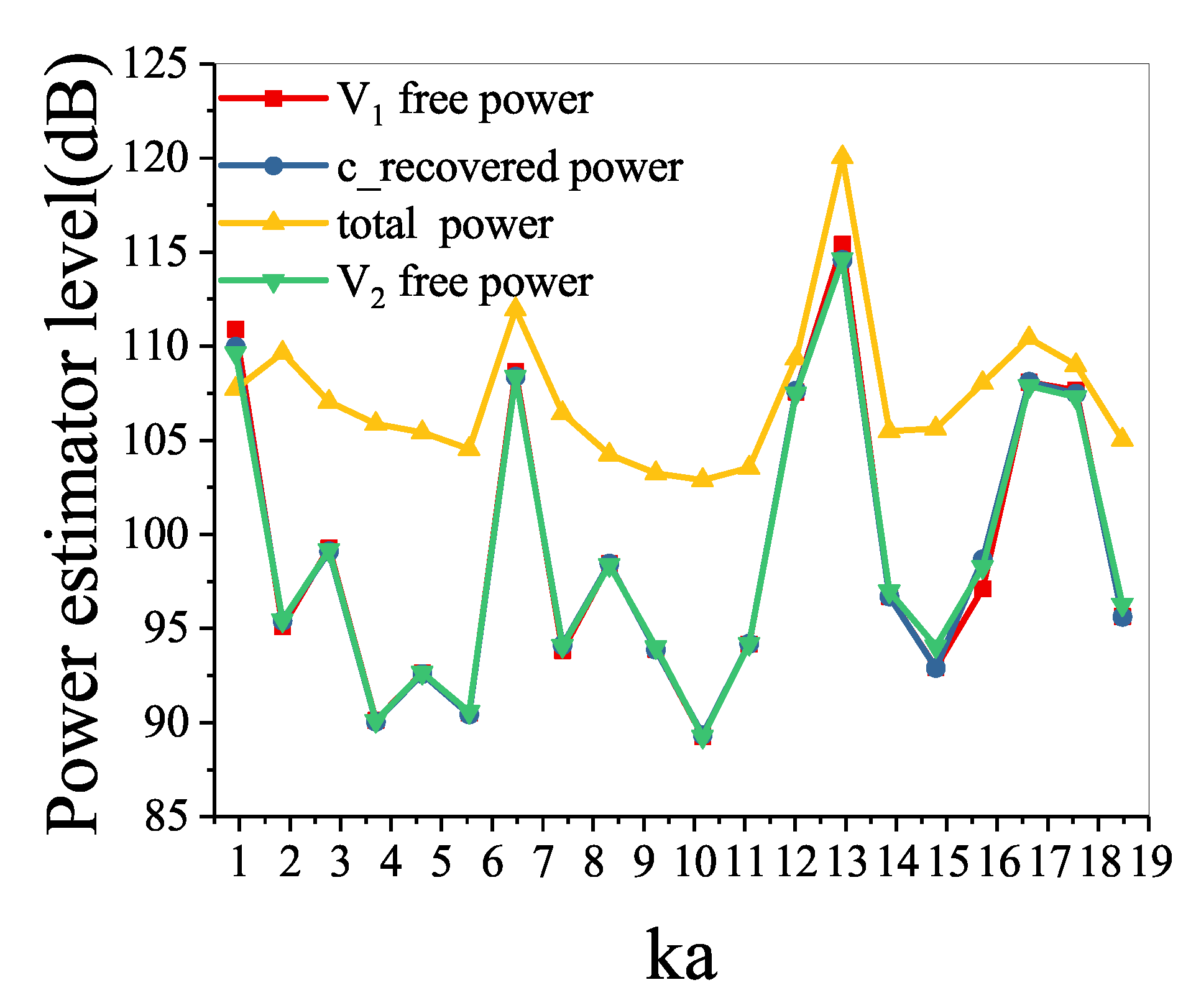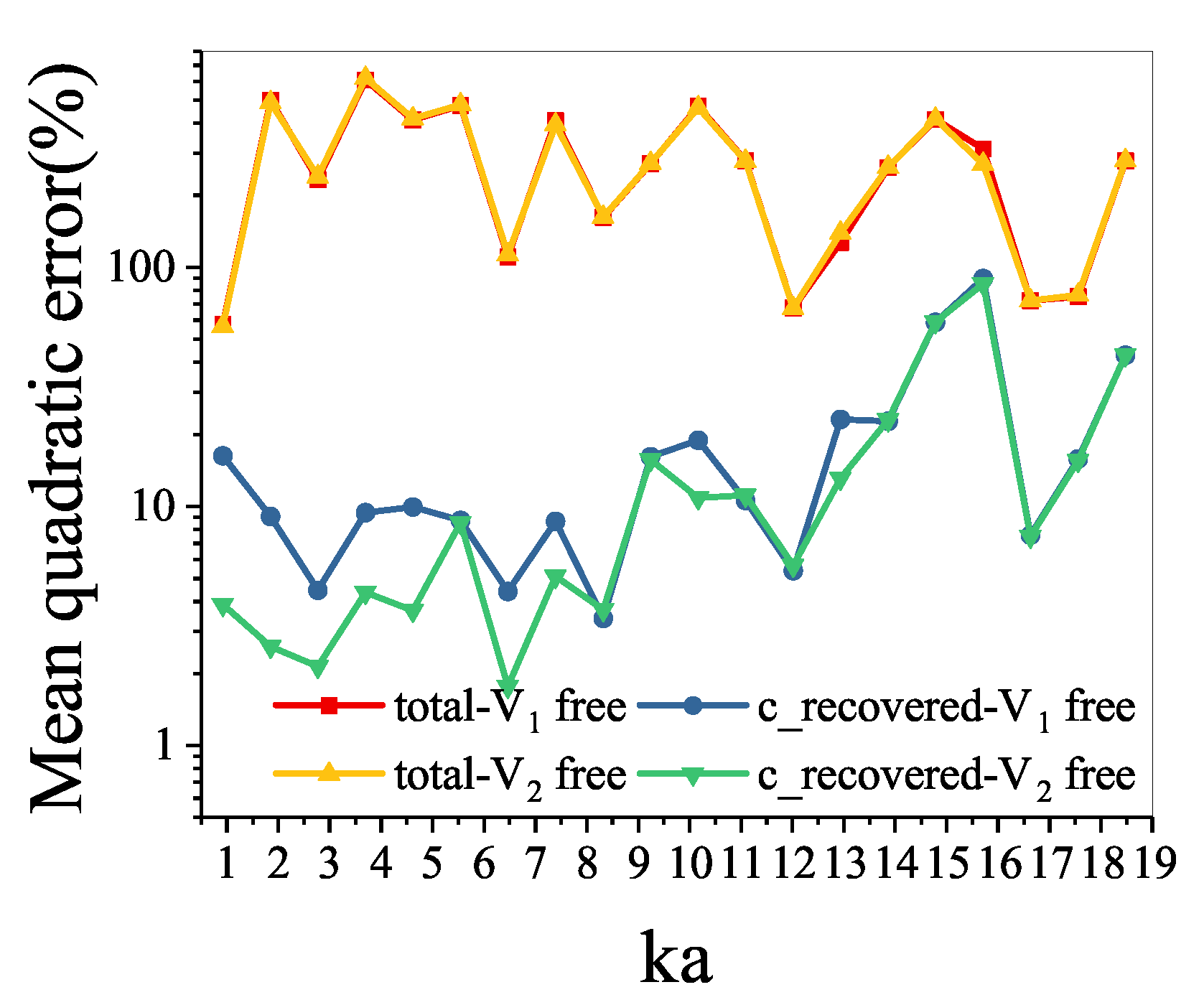Recovering the Free-Field Acoustic Characteristics of a Vibrating Structure from Bounded Noisy Underwater Environments
Abstract
:1. Introduction
2. Theory
2.1. Sound Field Separation
2.2. Subtraction of the Scattered Field
2.3. Discretization
3. Numerical Simulations
3.1. In a Bounded Noisy Air Environment
3.2. In a Bounded Noisy Underwater Environment
4. Conclusions
Author Contributions
Funding
Institutional Review Board Statement
Informed Consent Statement
Data Availability Statement
Conflicts of Interest
Abbreviations
| FFR | Free field recovery |
| BEM | Boundary element method |
| NAH | Nearfield acoustic holography |
| SONAH | Statistically optimized nearfield acoustic holography |
| iPTF | inverse patch transfer functions method |
| SIRE | Supersonic intensity in reverberant environments |
| ESM | Equivalent source method |
| SPL | Sound pressure level |
| SNR | Signal-to-noise ratio |
References
- Pavić, G.; Du, L. Coupling of sound spaces by plane surface harmonics and its application to sound source characterization. J. Sound Vib. 2019, 440, 1–22. [Google Scholar] [CrossRef]
- Barnard, A.R.; Hambric, S.A.; Maynard, J.D. Underwater measurement of narrowband sound power and directivity using Supersonic Intensity in Reverberant Environments. J. Sound Vib. 2012, 331, 3931–3944. [Google Scholar] [CrossRef]
- Pachner, J. Investigation of Scalar Wave Fields by Means of Instantaneous Directivity Patterns. J. Acoust. Soc. Am. 1956, 28, 90–92. [Google Scholar] [CrossRef]
- Weinreich, G.; Arnold, E.B. Method for measuring acoustic radiation fields. J. Acoust. Soc. Am. 1980, 68, 404–411. [Google Scholar] [CrossRef]
- Tsukernikov, I.E. Calculation of the field of a sound source in a bounded space. Sov. Phys. Acoust. Ussr 1989, 35, 304–306. [Google Scholar]
- Williams, E.G.; Maynard, J.D.; Skudrzyk, E. Sound source reconstructions using a microphone array. J. Acoust. Soc. Am. 1980, 68, 340–344. [Google Scholar] [CrossRef]
- Maynard, J.D.; Williams, E.G.; Lee, Y. Nearfield acoustic holography: I. Theory of generalized holography and the development of NAH. J. Acoust. Soc. Am. 1985, 78, 1395–1413. [Google Scholar] [CrossRef]
- Veronesi, W.A.; Maynard, J.D. Nearfield acoustic holography (NAH) II. Holographic reconstruction algorithms and computer implementation. J. Acoust. Soc. Am. 1987, 440, 1307–1322. [Google Scholar] [CrossRef]
- Hald, J. Patch holography in cabin environments using a two-layer handheld array with an extended SONAH algorithm. In Proceedings of the Euronoise, Tampere, Finland, 30 May–1 June 2006. [Google Scholar]
- Jacobsen, F.; Chen, X.; Jaud, V. A comparison of statistically optimized near field acoustic holography using single layer pressure velocity measurements and using double-layer pressure measurements. J. Acoust. Soc. Am. 2008, 123, 1842–1845. [Google Scholar] [CrossRef] [PubMed] [Green Version]
- Aucejo, M.; Totaro, N.; Guyader, J.L. Identification of source velocities on 3D structures in non-anechoic environments: Theoretical background and experimental validation of the inverse patch transfer functions method. J. Sound Vib. 2010, 329, 3691–3708. [Google Scholar] [CrossRef] [Green Version]
- Forget, S.; Totaro, N.; Guyader, J.L.; Schaeffer, M. Source fields reconstruction with 3D mapping by means of the virtual acoustic volume concept. J. Sound Vib. 2016, 381, 48–64. [Google Scholar] [CrossRef]
- Xiang, S.; Jiang, W.; Pan, S. Sound source identification in a noisy environment based on inverse patch transfer functions with evanescent Green. J. Sound Vib. 2015, 359, 68–83. [Google Scholar] [CrossRef]
- Xiang, S.; Jiang, W.; Jiang, H.; Gao, J. Reconstructing the normal velocities of acoustic sources in noisy environments using a rigid microphone array. J. Acoust. Soc. Am. 2016, 140, 2082–2090. [Google Scholar] [CrossRef]
- Romano, A.J.; Bucaro, J.A.; Houston, B.H.; Williams, E.G. On a novel application of the Helmholtz integral in the development of a virtual sonar. J. Acoust. Soc. Am. 2000, 108, 2823–2828. [Google Scholar] [CrossRef]
- Langrenne, C.; Melon, M.; Garcia, A. Boundary element method for the acoustic characterization of a machine in bounded noisy environment. J. Acoust. Soc. Am. 2007, 121, 2750–2757. [Google Scholar] [CrossRef] [PubMed]
- Bi, C.X.; Chen, X.Z.; Chen, J. Sound field separation technique based on equivalent source method and its application in nearfield acoustic holography. J. Acoust. Soc. Am. 2008, 123, 1472–1478. [Google Scholar] [CrossRef] [PubMed]
- Bi, C.X.; Stuart Bolton, J. An equivalent source technique for recovering the free sound field in a noisy environment. J. Acoust. Soc. Am. 2012, 131, 1260–1270. [Google Scholar] [CrossRef] [PubMed]
- Bi, C.X.; Hu, D.Y.; Zhang, Y.B.; Bolton, J.S. Reconstruction of the free-field radiation from a vibrating structure based on measurements in a noisy environment. J. Acoust. Soc. Am. 2013, 134, 2823–2832. [Google Scholar] [CrossRef] [PubMed]
- Bi, C.X.; Hu, D.Y.; Zhang, Y.B.; Jing, W.Q. Identification of active sources inside cavities using the equivalent source method-based free-field recovery technique. J. Sound Vib. 2015, 346, 153–164. [Google Scholar] [CrossRef]
- Lin, W.; Li, S.; Liu, S.; Gao, H.; Gao, J.; Liu, Y. An improved method for recovering the acoustic characteristics of a target sound source sitting on plane by boundary element method. Appl. Acoust. 2020, 165, 107316. [Google Scholar] [CrossRef]
- Wu, H.; Li, D.; Yu, L.; Jiang, W. A boundary element method based near field acoustic holography in noisy environments. J. Acoust. Soc. Am. 2020, 147, 3360–3371. [Google Scholar] [CrossRef]
- Sternini, S.; Rakotonarivo, S.T.; Sarkar, J.; Bottero, A.; Kuperman, W.A.; Williams, E.G. Bistatic scattering of an elastic object using the structural admittance and noise-based holographic measurements. J. Acoust. Soc. Am. 2020, 148, 734–747. [Google Scholar] [CrossRef]
- Everstine, G.C.; Henderson, F.M. Coupled finite element/boundary element approach for fluid–structure interaction. J. Acoust. Soc. Am. 1990, 87, 888–896. [Google Scholar] [CrossRef]
- Wu, T.W. Boundary Element Acoustics: Fundamentals and Computer Codes; Wit Press: Southampton, UK, 2000. [Google Scholar]
- Citarella, R.; Landi, M. Acoustic analysis of an exhaust manifold by Indirect Boundary Element Method. Open Mech. Eng. J. 2011, 5, 138–151. [Google Scholar] [CrossRef] [Green Version]
- Xu, Z.; Shen, R.; Hua, H. Structural-Acoustic Coupling Problem of an Immersed Shell by FEM/IBEM. J. Vib. Eng. 2002, 15, 363–367. [Google Scholar]
- Tobocman, W. Calculation of acoustic wave scattering by means of the Helmholtz integral equation. I. J. Acoust. Soc. Am. 1984, 76, 1549–1554. [Google Scholar] [CrossRef]
- Schenck, H.A. Improved integral formulation for acoustic radiation problems. J. Acoust. Soc. Am. 1968, 44, 41–58. [Google Scholar] [CrossRef]
- Atalla, N.; Bernhard, R.J. Source fields reconstruction with 3D mapping by means of the virtual acoustic volume concept. Appl. Acoust. 1994, 43, 271–294. [Google Scholar] [CrossRef]
- Arjunan, A.; Wang, C.; Yahiaoui, K.; Mynors, M.; Morgan, T.; Nguyen, B.; English, M. Sound frequency dependent mesh modelling to simulate the acoustic insulation of stud based double-leaf walls. In Proceedings of the 2014 Leuven Conference on Noise and Vibration Engineering (ISMA2014), Leuven, Belgium, 15–17 September 2014. [Google Scholar]
- Idelsohn, S.R.; Onate, E.; Del Pin, F.; Calvo, N. Fluid–structure interaction using the particle finite element method. Comput. Methods Appl. Mech. Eng. 2006, 195, 2100–2123. [Google Scholar] [CrossRef] [Green Version]
- Giannella, V.; Lombardi, R.; Pisani, M.M.; Federico, L.; Barbarino, M.; Citarella, R. A Novel Optimization Framework to Replicate the Vibro-Acoustics Response of an Aircraft Fuselage. Appl. Sci. 2020, 10, 2473. [Google Scholar] [CrossRef] [Green Version]










| Thickness | Young Modulus | Poisson’s Ratio | Density | Damping |
|---|---|---|---|---|
| m | N/m | 2710 kg/m | 0 |
Publisher’s Note: MDPI stays neutral with regard to jurisdictional claims in published maps and institutional affiliations. |
© 2021 by the authors. Licensee MDPI, Basel, Switzerland. This article is an open access article distributed under the terms and conditions of the Creative Commons Attribution (CC BY) license (https://creativecommons.org/licenses/by/4.0/).
Share and Cite
Lin, W.; Li, S. Recovering the Free-Field Acoustic Characteristics of a Vibrating Structure from Bounded Noisy Underwater Environments. Sensors 2021, 21, 5521. https://doi.org/10.3390/s21165521
Lin W, Li S. Recovering the Free-Field Acoustic Characteristics of a Vibrating Structure from Bounded Noisy Underwater Environments. Sensors. 2021; 21(16):5521. https://doi.org/10.3390/s21165521
Chicago/Turabian StyleLin, Wei, and Sheng Li. 2021. "Recovering the Free-Field Acoustic Characteristics of a Vibrating Structure from Bounded Noisy Underwater Environments" Sensors 21, no. 16: 5521. https://doi.org/10.3390/s21165521
APA StyleLin, W., & Li, S. (2021). Recovering the Free-Field Acoustic Characteristics of a Vibrating Structure from Bounded Noisy Underwater Environments. Sensors, 21(16), 5521. https://doi.org/10.3390/s21165521





